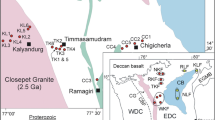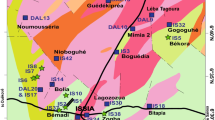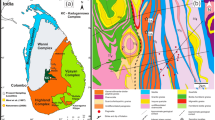Summary
Kalsilite, leucite and hibonite occur together with spinel, corundum, sphene, perovskite, Ti-phlogopite and K-feldspar in a granulite facies gneiss in the Punalur district in Kerala, southern India. Kalsilite-leucite-perovskite-phlogopite and kalsilite-hibonite-spinelcorundum formed distinct, texturally equilibrated assemblages during the granulite facies metamorphism. Sphene occurs as coronas on perovskite suggesting the retrograde breakdown of the perovskite-leucite association; leucite is partially altered to symplectites of K-feldspar and kalsilite, while hibonite shows partial replacement by corundum and perovskite in spinel-rich domains. Unlike other terrestrial hibonites the majority of the Punalur hibonites contain no significant rare earths (ΣREE < 0.01 atoms per 190), with a composition approximated by Ca0.85Ti0.9Mg0.25Fe0.25Ali10.4O19 although a few zoned hibonites have REE rich cores with ΣREE > 0.6 atoms per 19 O. Garnet-hypersthene granulites from Punalur and garnet-charnockites from elsewhere in Kerala suggest metamorphism at 700–800°C and 3.5–6.5 kbars; consistent with experimentally determined stability limit of leucite of low a(H2O). The metamorphic conditions recorded by the Punalur assemblages testify to relatively low pressure conditions for a granulite facies terrain but are by no means unique. The scarcity of potassium feldspathoid in the metamorphic record must therefore be attributed to the exceptional compositional requirements of extreme silica undersaturation combined with low Na/K ratios.
Zusammenfassung
Kalsilit, Leuzit, and Hibonit kommen zusammen mit Spinell, Korund, Titanit, Perovskit, Ti-Phlogopit and K-Feldspat in einem granulitfaziellen Gneiss des Punalur-Distriktes in Kerala, Süd-Indien vor. Kalsilit-Leuzit-Perovskit-Phologopit and Kalsilit-Hibonit-Spinell-Korund bildeten wdhrend der Granulit-Fazies-Metamorphose deutliche Paragenesen, die texturell im Gleichgewicht sind. Titanit kommt als Koronas auf
Perovskit vor und dies weist auf den retrograden Zerfall der Perovskit-Leuzit Paragenese hin. Leuzit ist teilweise zu Symplektiten von K-Feldspat und Kalsilit umgewandelt, während Hibonit Verdrängung durch Korund und Perovskit in spinellreichen Domänen zeigt. Im Gegensatz zu anderen terrestrischen Hiboniten, führt die Mehrzahl der Hibonite von Punalur, mit einer ungefähren Zusammensetzung von Ca0.85Ti0.9Mg0.58Fe0.25Ali10.4O19, keine wesentlichen Seltenen-Erd-Gehalte (ΣSEE < 0.01 Atome per 19 0). Trotzdem gibt es einige wenige zonierte Hibonite, deren Kerne reich an SEE sind mit ESEE > 0.6 Atome per 19 O. Granat-Hypersthen Granulite aus Punalur and Granat-Charnockite von anderen Teilen Kerala's weisen auf eine Metamorphose bei 700–800°C und 3.5–6.5 kbar hin; dies ist in guter Übereinstimmung mit der experimentell bestimmten Stabilitätsgrenze von Leuzit bei niederigen a(H2O). Die metamorphen Bedingungen, die die Punalur-Paragenesen dokumentieren, zeigen relativ niedrige Druckbedingungen für ein Granulit-Fazies Terrain an; das ist aber keineswegs einmalig. Die Seltenheit von Kali-Feldspathoiden während der metamorphen Entwicklung muß deshalb auf die ungewöhnlichen Erfordernisse extremer Silizium-Untersättigung, zusammen mit niedrigen Na/K-Verhältnissen, zurückgehen.
Similar content being viewed by others
References
Burns RG, Burns VM (1984) Crystal chemistry of meteoritic hibonites. J Geophys Res 89: C313-C321
Chacko T, Ravindra Kumar GR, Newton RC (1987) Metamorphic P-T conditions of the Kerala (South India) khondalite belt, a granulite facies supracrustal terrain. J Geol 95: 343–358
Crawford A (1969) Reconnaissance Rb-Sr dating of Precambrian rocks of southern Peninsula India. J Geol Soc India 10: 117–166
Curien H, Guillemin C, Orcel J, Sternberg M (1956) La hibonite, nouvelle espece minerale. C R Acad Sci Paris 242: 2845–2847
Deer WA, Howie RA, Zussman J (1964) Rock forming minerals. Volume 4: Framework silicates. Longman, London, 435 pp
Harley SL (1984) An experimental study of the partitioning of Fe and Mg between garnet and orthopyroxene. Contrib Mineral Petrol 86: 359–373
—— (1984) The origins of granulites: a metamorphic perspective. Geol Mag 126: 215–247
Holland TJB, Powell R (1985) An internally consistent thermodynamic dataset with uncertainties and and correlations: 2 data and results. J Metamorph Geol 3: P
Kerrich R, Fyfe Ws, Barnett BB, Willmore LM (1988) Corundun, Cr-muscovite rocks at O'Briens, Zimbabwe: the conjunction of hydrothermal desilicification and LIL enrichment-geochemical and isotopic evidence. Contrib Mineral Petrol 95: 481–498
Kröner A, Williams IS, Compston W, Vitanage PW, Perera LRK (1987) Zircon ion-microprobe dating of granulites in Sri Lanka. J Geol 95: 775–792
Kuzmin AM (1960) Hogbomite from Gornaya Shoriya. Geol Geof 4: 63–75
Maaskant P, Coolen JJMMM, Burke EAJ (1980) Hibonite and coexisting zoisite in a calcsilicate granulite from southern Tanzania. Mineral Mag 43: 995–1003
Powell R, Holland TJB (1988) An internally consistent dataset with uncertainties and correlations, 3: applications to geobarometry, worked examples and a computer program. J Metamorph Geol 6: 173–204
Santosh M, Sandiford M, Reed SJB (in press) Zoned hibonites from Punalur, South India. Mineral Mag
Scarfe CM, Luth WC, Tuttle OF (1966) An experimental study bearing on the absence of leucite in plutonic rocks. Amer Mineral 51: 726–735
Yakovlevskava TA (1961) Hibonite from Gornaya Shoriya. Zap Vscs Min Obshch 90: 458–461
Whitney PR, McClelland JM (1983) Origin of biotite-hornblende-garnet coronas between oxides and plagioclase in olivine metagabbros, Adirondack region, New York. Contrib Mineral Petrol 82: 34–41
Author information
Authors and Affiliations
Additional information
With 6 figures
Rights and permissions
About this article
Cite this article
Sandiford, M., Santosh, M. A granulite facies kalsilite-leucite-hibonite association from Punalur, Southern India. Mineralogy and Petrology 43, 225–236 (1991). https://doi.org/10.1007/BF01166894
Received:
Accepted:
Issue Date:
DOI: https://doi.org/10.1007/BF01166894




